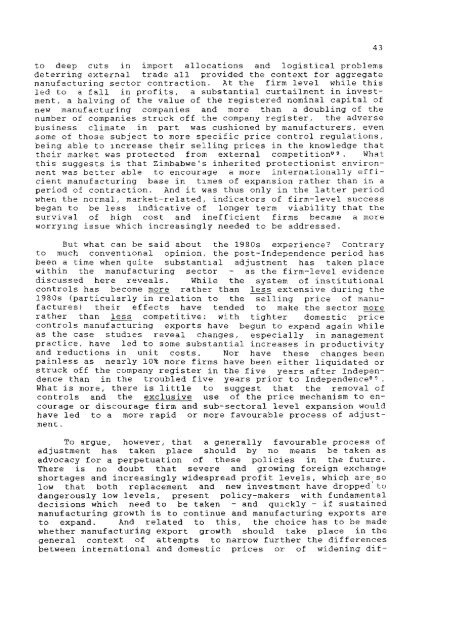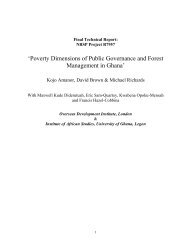Zimbabwe - Overseas Development Institute
Zimbabwe - Overseas Development Institute
Zimbabwe - Overseas Development Institute
You also want an ePaper? Increase the reach of your titles
YUMPU automatically turns print PDFs into web optimized ePapers that Google loves.
to deep cuts i n import a l l o c a t i o n s and l o g i s t i c a l problems<br />
d e t e r r i n g external trade a l l provided the context f o r aggregate<br />
manufacturing sector c o n t r a c t i o n - At the f i r m l e v e l while t h i s<br />
led to a f a l l i n p r o f i t s , a s u b s t a n t i a l curtailment i n i n v e s t <br />
ment, a h a l v i n g of the value of the r e g i s t e r e d nominal c a p i t a l of<br />
new manufacturing companies and more than a doubling of the<br />
number of companies struck off the company r e g i s t e r , the adverse<br />
business climate i n part was cushioned by manufacturers, even<br />
some of those subject to more s p e c i f i c p r i c e c o n t r o l r e g u l a t i o n s ,<br />
being able to increase t h e i r s e l l i n g p r i c e s i n the knowledge that<br />
t h e i r market was protected from external competition""- What<br />
t h i s suggests i s that <strong>Zimbabwe</strong>'s i n h e r i t e d p r o t e c t i o n i s t environment<br />
was b e t t e r able to encourage a more i n t e r n a t i o n a l l y e f f i <br />
c i e n t manufacturing base i n times of expansion rather than i n a<br />
period of c o n t r a c t i o n - And i t was thus only i n the l a t t e r period<br />
when the normal, market-related, i n d i c a t o r s of f i r m - l e v e l success<br />
began to be l e s s i n d i c a t i v e of longer term v i a b i l i t y that the<br />
s u r v i v a l of high cost and i n e f f i c i e n t firms became a more<br />
worrying issue which i n c r e a s i n g l y needed to be addressed.<br />
But what can be s a i d about the 1980s experience? Contrary<br />
to much conventional opinion, the post-Independence period has<br />
been a time when quite s u b s t a n t i a l adjustment has taken place<br />
w i t h i n the manufacturing sector - as the f i r m - l e v e l evidence<br />
discussed here r e v e a l s . While the system of i n s t i t u t i o n a l<br />
c o n t r o l s has become more rather than l e s s extensive during the<br />
1980s ( p a r t i c u l a r l y i n r e l a t i o n to the s e l l i n g p r i c e of manufactures)<br />
t h e i r e f f e c t s have tended to make the sector more<br />
rather than l e s s competitive; with t i g h t e r domestic p r i c e<br />
c o n t r o l s manufacturing exports have begun to expand again while<br />
as the case studies reveal changes, e s p e c i a l l y i n management<br />
p r a c t i c e , have led to some s u b s t a n t i a l increases i n p r o d u c t i v i t y<br />
and reductions i n u n i t costs. Nor have these changes been<br />
p a i n l e s s as nearly 10% more firms have been e i t h e r l i q u i d a t e d or<br />
struck off the company r e g i s t e r i n the f i v e years a f t e r Independence<br />
than i n the troubled f i v e years p r i o r to Independence''.<br />
What i s more, there i s l i t t l e to suggest that the removal of<br />
c o n t r o l s and the e x c l u s i v e use of the p r i c e mechanism to encourage<br />
or discourage f i r m and sub-sectoral l e v e l expansion would<br />
have l e d to a more r a p i d or more favourable process of adjustment<br />
.<br />
To argue, however, that a g e n e r a l l y favourable process of<br />
adjustment has taken place should by no means be taken as<br />
advocacy f o r a perpetuation of these p o l i c i e s i n the future-<br />
There i s no doubt that severe and growing f o r e i g n exchange<br />
shortages and i n c r e a s i n g l y widespread p r o f i t l e v e l s , which are so<br />
low that both replacement and new investment have dropped'to<br />
dangerously low l e v e l s , present policy-makers with fundamental<br />
decisions which need to be taken - and q u i c k l y - i f sustained<br />
manufacturing growth i s to continue and manufacturing exports are<br />
to expand- And r e l a t e d to t h i s , the choice has to be made<br />
whether manufacturing export growth should take place i n the<br />
general context of attempts to narrow f u r t h e r the d i f f e r e n c e s<br />
between i n t e r n a t i o n a l and domestic p r i c e s or of widening d i f -
















